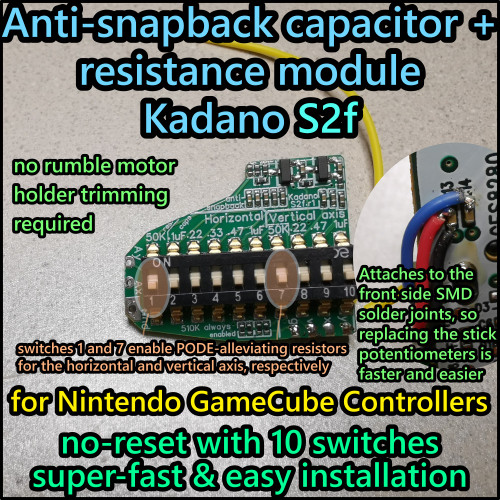This module provides a switch that toggles button remapping on and off. You can wire it to any two digital buttons on Gamecube controllers to have them swapped. Most often used for Z jump, but can also be used for swapping other digital buttons.
As button remapping has only been popular for a short time and it takes time to find out whether an altered button layout really works better for you, I think button remapping should only be done as a toggle installation, so that you can switch back without needing to solder.
These modules are very small and fit on top of the PCB on the front. For installing, you need a screwdriver to open the controller (sold separately) and a soldering station as well as solder and flux. If you install it like I did in the photos, with direct wiring to the chip pins, good flux paste / gel is crucial to prevent bridging pins and making sure that the solder connection is sturdy.
The pre-wired options are easier to install, as the wires are already cut to the ideal length, presoldered and pretinned by me. If you only want to remap X/Y with Z, shorter wire length works well. Longer wire length also enables swapping L/R or any other digital buttons with each other.
Installation time: ~15-30 minutes depending on experience / skill level.
This is an expert level installation that should only be attempted by professionals or hobbyists who are already quite experienced at intricate soldering.
It's quite easy to overheat the chip's legs and thus kill the respective digital button completely if you stay there with your soldering iron for too long. I don't offer any warranty for cases like this. You alone are responsible for installing this module safely and properly.
Installation steps:
1. Remove the adhesive protection layer and stick the module to the controller board, pressing it against there strongly for 5 seconds.
2. Identify the chip legs that correspond to the digital buttons that you want to swap. Use my chip pinout in the photos of this listing to find the positions.
3. Use a scalpel / xacto knife or good fine tweezers to lift the legs of the chip. You need to do that while applying heat to melt the solder, so you should either use flux, a bit of extra solder and a soldering iron with a relatively fine tip or a hot air rework station. With both, you need to be very careful not to apply heat for too long.
4. (Skip if you bought the pre-wired option) Cut wires of appropriate lengths running from the lifted legs and the pads below to the corresponding solder points on the board.
I recommend using thin silicone wires (as I use for the pre-wired option) as these are flexible enough to not transmit slight vibrations / impacts to the solder joints, and unlike PVC wires won't melt and potentially expose the copper inside (which would lead to short circuits and unwanted / permanent button inputs).
5. Solder the wire from the "1pad" solder point to one of the pads that you lifted the legs off, then solder the "1leg" solder point wire to the lifted leg. Repeat for "2pad" and "2leg" for the other button.
6. Attach the controller to a Wii or PC with SmashScope button test running and press the buttons that you wanted to swap while the switch is in the off position. If they work properly, flip the switch to the other side and check whether they now perform only the swapped button's input.
If they don't work properly, your soldering is faulty and needs to be redone. If both toggle states work properly, your installation is done.
PCB type: lead-free, HASL (black) / ENIG (green). Compliant with RoHS (Restriction of Hazardous Substances, such as lead). (Future board revisions will be ENIG / gold-plated.)
Solder type: lead-free (RoHS compliant).
Wire type: silicone coated, more flexible and won't melt / cause toxic fumes during soldering, as 'normal' PVC wires do. Wire ends stripped and pre-tinned.
Wire size: 28 AWG (copper diameter 0.36 mm, outer diameter 1.2 mm, 0.08 mm² copper cross-section)
Switch types: cheap type requires a bit more force to toggle, feels less snappy and the casing is less sturdy. The premium type is more expensive, but more sturdy and recommended in most cases by default.
Designed for usage in Nintendo Gamecube controllers, but can also be installed to other controllers that use digital buttons that are pulled high.
PCB design and original idea by me (Kadano), PCBs produced and partially assembled by factory. Soldering of the 4 wires (only with the pre-wired option)(pre-tinned for easy soldering) as well as quality control done by me.
1 Review Hide Reviews Show Reviews
-
What an awesome piece of tech
I wanted to try out z jumping but didn’t want to have to go out and buy a phob just to try it. Assuming you have the skills to solder or know someone who can, this board is perfect. I got everything soldered and is working as expected. Kadano was also great to work with when I needed help with my order! Thank you!











